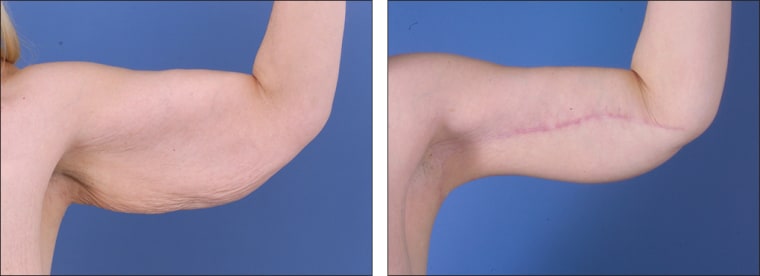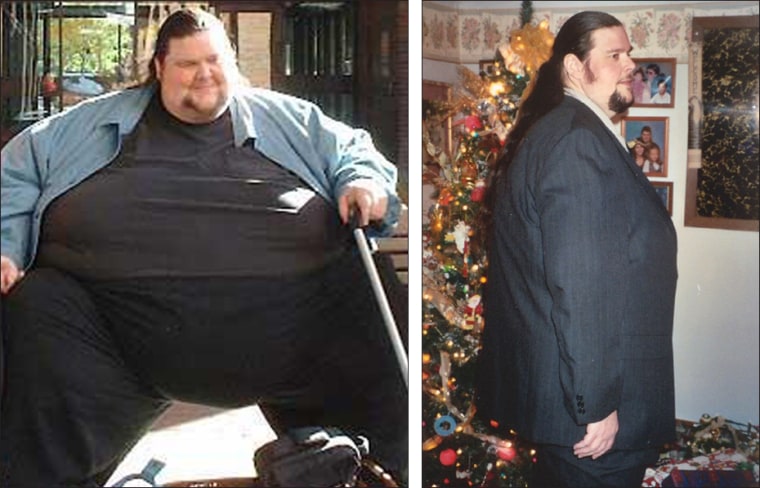Kirk Thompson, 41, had lost 400 pounds in the two years since his gastric bypass, or "stomach stapling," operation at Ohio State University Medical Center in October 2001. Down from a peak weight of 745 pounds, the West Virginia native was closer to a normal weight than he had been in decades. After years of suffering congestive heart failure and rarely leaving his home except to go to the hospital, Thompson’s health was improving.
But while he’d lost a huge amount of weight, when he looked in the mirror he saw the same obese man he’d been since high school. He was still carrying 100 pounds of extra skin, including layers of flesh around his abdomen that hung down nearly to his knees.
“It was hard to walk,” says Thompson, who works with a weight-loss support site called ObesityHelp.com. “It made me so off-balance that I was almost stumbling.”
So Thompson went back to Ohio State to have the skin around his abdomen and upper legs tightened.
About 25 pounds of loose skin were removed by a tummy tuck and lower body reshaping, an operation that is becoming one of the fastest growing areas of plastic surgery in the United States.
“It feels great and really strange,” says Thompson, who lost 12 inches around his waist from the plastic surgery. “It made my whole life different.”
Driven by the American obesity epidemic and by the high-profile success stories of celebrities such as NBC’s Al Roker and the novelist Anne Rice, the number of weight-loss, or bariatric, procedures is expected to top 144,000 this year, according to the American Society for Bariatric Surgeries. But the road to weight loss doesn't always end there. Many of those patients will seek a plastic surgeon to help their formerly obese bodies look more normal.

Statistics from the American Society of Plastic Surgeons show that 52,049 people had some kind of body contouring following massive weight loss in 2003, the first year the association has tracked that specific category. Plastic surgeons say it's clear there has been a significant increase in demand for these procedures.
"People are now a lot more aware that skin surgery may be part of their gastric bypass operations," says Dr. Robin Blackstone, a surgeon and director of the Scottsdale Bariatric Center in Arizona.
Five years ago Dr. Albert Cram, chief of plastic surgery at the University of Iowa, used to perform one tummy tuck or body lift a month on patients who had lost massive amounts of weight. Now his department averages one or two a week.
“It’s growing significantly,” he says.
People who have lost more than 100 pounds may find that weight-related illnesses like diabetes or hypertension go away, but they still don’t look thin. The skin becomes like an elastic band that has been stretched too far. No matter how much exercise, or what kind of exercise, they do, the skin doesn’t go back to its normal size.
“Expanded skin doesn’t have the same capabilities as before weight gain; it’s damaged skin with stretch marks,” says Dr. Jeffrey Kenkel, vice chairman of plastic surgery at the University of Texas Southwestern Medical Center in Dallas. “From the head down to the ankles, there’s a lot of overhanging skin.”
Not just about vanity
For some weight-loss surgery patients, a body lift isn’t about vanity or for simply cosmetic purposes. Hanging folds of flesh around the abdomen can cause rashes, chronic infections, hygiene problems and difficulties with exercising. These people may have conquered the health problems like diabetes that accompany excessive weight, but their clothes still don’t fit properly.
“The profound effect is on body image,” says Dr. J. Peter Rubin, director of the Life After Weight Loss Program at the University of Pittsburgh Medical Center, a center which specializes in body contouring and counseling. “The plastic surgery after weight loss can have just as powerful an effect on someone as the gastric bypass.”
Not every person who has a weight-loss operation will see the need for additional surgery to counteract skin laxity. Age and genetics play a part, with older patients and those whose weight tops 400 pounds being the most likely candidates, plastic surgeons say.
The most common procedure is the tummy tuck, or the abdominoplasty, an operation designed to remove the “apron” of skin hanging from the stomach. Some people have skin removed from their sides and back, and their buttocks reshaped.
Other weight-loss patients may need a lower body lift, which includes lifting the skin up from the knees almost like pulling up a pair of pants, says Dr. Deborah White, a plastic surgeon in Scottsdale, Ariz. Some may need tightening and lifting in their upper arms, the chest or breasts.

“A person’s arms may not go into the sleeves of their clothes because there’s too much extra skin,” says White.
Most of the skin-lifting procedures are scheduled about a year to 18 months after a patient’s gastric bypass so that the majority of the weight has already been lost.
“The key issue is that a patient’s weight is stable and is as close to the ideal body weight as possible,” says Rubin.
Recovery includes several days of hospitalization. After six weeks, the patient can return to work and can usually begin exercising after eight weeks, says Rubin. Scars can take a year to heal.
But recovery may not be the most difficult part of body contouring. Getting coverage from an insurance company may be. As the number of people getting gastric bypass has surged, commercial insurers are becoming more resistant to covering the $30,000 procedure, citing safety issues. They're also more likely to deny payment for any operation not considered medically necessary.
On average the cost of an abdominal tuck is between $6,000 and $10,000, depending on the area of the country. For a lower body lift with a thigh reshaping, the price can reach $10,000 to $20,000. A complete body contouring, including face lift, can top $30,000, according to estimates.
Most doctors spread the procedures, which can take five to 10 hours in surgery, over several months.
'Big operation'
While skin surgery doesn’t carry the same risks as gastric bypass -- which has a nationwide mortality rate of 1 in 200, according to doctors -- there can be complications. The patient is placed under general anesthesia, which can be risky for someone who may have weight-related heart problems.
There’s a danger of post-surgical blood clots. Long incisions can be slow to heal, fluid can collect between the muscle walls and the skin and severe scabbing can slow recovery.
“It is a big operation and recovery is extensive,” says Cram. “If we tighten as much as we can, the patient can have problems bending forward and can feel constrained for awhile.”
While any plastic surgeon can perform body contouring, Kenkel urges patients to find an accredited overnight facility and seek a doctor who has experience with other weight-loss patients.
“It does require a magnitude of care,” says Kenkel. “Other techniques don’t fit these patients because they’ve lost such volume in their tissue that needs to be replaced.”
Thompson is going back for more skin tightening in April, when doctors are expecting to remove another 35 pounds of skin from his chest and sides. His legs, arms and back will be reworked in another series of surgeries.
He acknowledges that the surgeries are difficult but he isn't worried.
"The answer at the end is, it's worth the pain," he says. "I was so large I couldn't go out. Now I fit in and I'm almost totally normal."
